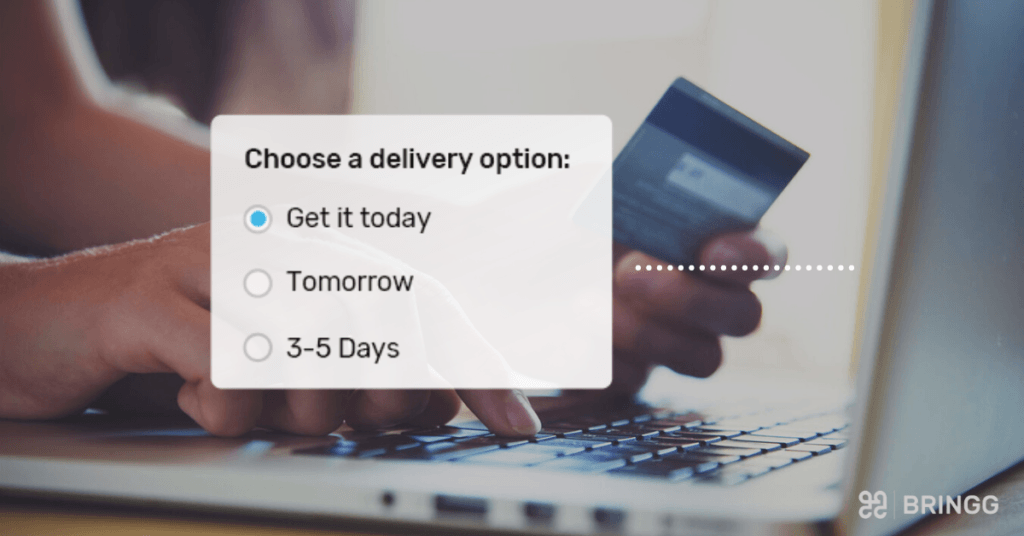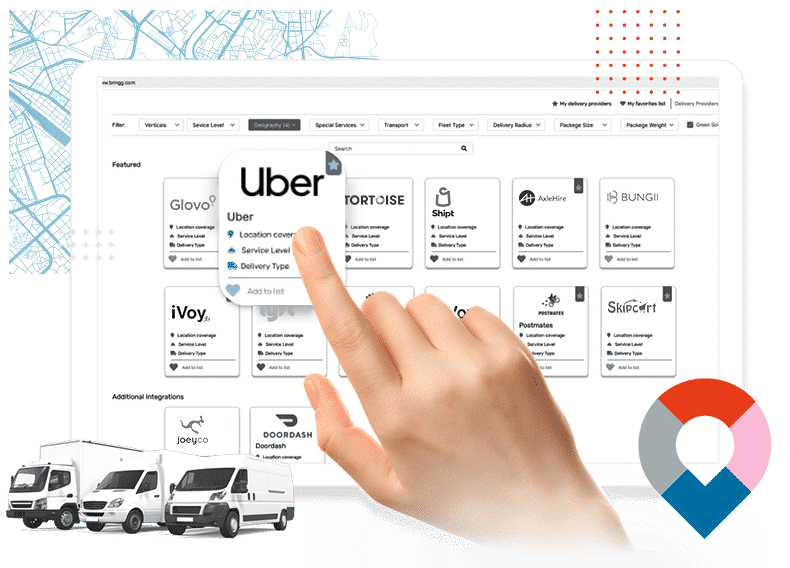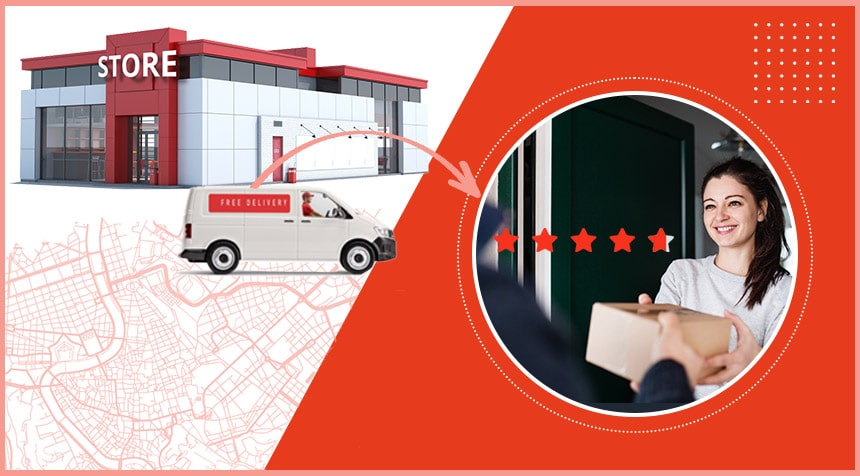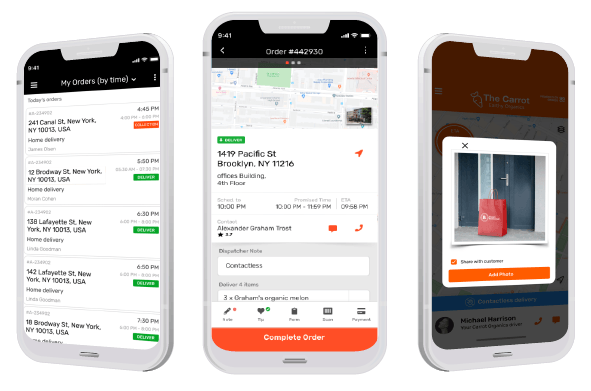The on demand economy has ushered in an entirely new era of consumer expectations around speed, cost, and convenience. How can businesses adapt to the on demand delivery market and guarantee the best experience possible?
Market innovators such as Amazon and Uber have changed the way delivery operations work. With on demand delivery apps, customers want their orders ASAP, if not instantly.
In cities, on demand delivery has become a part of everyday life, with over half of urban customers expecting one-hour local delivery and large percentages of younger customers expecting the same. And now, fully 99% of retailers plan to offer same-day delivery within the next three years – with many aiming to reach 30-minute delivery times, too.
What is on demand delivery, and what’s changed?
On demand delivery is the process of retailers, restaurants, manufacturers, grocery stores, etc. being able to deliver orders quickly and with no advanced notice. On demand services have become particularly popular due to the popularization of the on demand delivery app, as well as the expansion of eCommerce due to COVID-19.
“Roughly 75 percent of apparel, hard goods, and specialty retailers intend to build out network capabilities that offer two-day or faster delivery, and 42 percent are aiming for one-day click-to-customer lead times by 2022.”
Mckinsey.com
While restaurants have had to provide customers with on demand services for decades, often in the form of just in time delivery, the phenomenon has expanded and requires delivery services to step up and get prepared.
Why do on demand delivery and fulfillment services fail?
The main reason that most on demand delivery operations fail is that brands don’t understand just how complex they are to manage.
Almost 1 in 4 companies struggle to meet delivery times because of travel distance. This challenge, along with a lack of visibility, points to delivery operations that are not set up for hyperlocal delivery.
Source: 2022 Bringg Barometer: State of Retail Delivery & Fulfillment
On demand delivery works through connecting all of your resources, systems and processes across the last mile of your supply chain while creating efficient, streamlined flows. This is the only way to reliably keep up in the on demand delivery market and fulfill online orders on time.
If you are challenged by launching or managing on demand delivery, chances are that you’ve struggled with the following:
Short time frames, high delivery volumes
The issue with on demand delivery is that there is a very short period between orders being accepted and being sent out.
On demand service leaves little room for human error, and therefore must be automated to be completely seamlessly and on time. With over 27% of shoppers abandoning carts when delivery options aren’t fast enough, automating the logistics of same-day or on demand deliveries is critical to capturing market share.
Functional silos, goals and KPIs
The job specialization that is required to scale enterprise delivery often results in separate functional teams, each acting according to its own objectives, priorities, KPIs, performance incentives and technologies. But this is the exact opposite of the real-time coordination across teams and platforms which is necessary to make on demand fulfillment a success.
These distinct systems must be turned into one synchronized unit to ensure that orders are prepared, staged, dispatched and delivered quickly. Often, new on demand delivery software must be integrated in to existing systems (e.g. POS, TMS and others).
Inflexible use of resources and delivery flows
When implementing an on demand fulfillment model into any company, team structures, performance objectives, and even roles and responsibilities need to be rethought.
For example, think about bringing on fleets with on demand delivery apps instead of eighteen-wheeler trucks designed for multi-day fulfillment. Similarly, dispatchers trained to manually plan routes will have to start using automation and dispatch software, and use their free time to manage customer expectations.
With the increase in on demand delivery apps and services, companies will find themselves using resources in different, and new, ways. For example, if store operations have decreased, retail teams may need to start picking and packing online orders for delivery.
Some businesses may need to reorganize many of their delivery services and processes and make challenging adaptations to their resources- including warehouse and store operations, dispatching, driver management, and customer-facing technologies – in order to provide the consumer with fast, convenient delivery and fulfillment on demand.
Lack of speed and automation
There’s no way around it: on demand deliveries must be dealt with in minutes, not even hours. Any inefficiencies or disconnect between the preparation, dispatch and delivery flows will result in poor operational performance and negative customer experiences.
On demand delivery gets even more complicated when it comes to scale, which leads to businesses wasting expensive resources. For example, if an order is not sent to prep or staging on time, or if the driver is notified to pick it up too early, then the driver will end up waiting around for the order and will probably miss the delivery window. If there is an inefficient staging process, then drivers or customers coming to pick up an order won’t receive it on time – and your on time delivery rate will fall.
The same is true of a retail delivery that encounters delays. Any time that was unaccounted for in the planning process wastes expensive resources, increases delivery times, and results in late deliveries and frustrated and dissatisfied customers.
The high costs associated with on demand deliveries
The last mile is the most expensive process in the supply chain. Companies are looking to save money, and this often results in issues when it comes to meeting on demand delivery expectations.
High operational costs are a direct result of attempting to deliver at high speed and volume, without full digitization, automation, and visibility into data. Good examples include choosing drivers, fleets or contractors without taking cost to deliver into consideration. Another is sending out orders for delivery without first checking if they can be batched with other orders going out in the same time window to the same area.
Furthermore, high-volume delivery like post and restaurant delivery are notoriously low margin and even the most popular on demand delivery apps operate at a loss. Compounding all of this is the fact that today’s consumer expects to receive at least one option with free shipping, and many even expect free same-day services. The delivery costs then fall on the business.
Managing on demand services post Covid-19
With everyone going online, omnichannel delivery has become more popular than ever – and demand issues have never been greater. Delivery providers are seeing packages stacked up in warehouses, waiting for service providers to have enough resources to deliver them. If on demand delivery (same or even next-day delivery) is promised, then every retail company and the logistics providers who service them must ensure that orders are delivered on time.
These challenges come on top of managing deliveries during ‘usual’ peak seasons, such as the holiday rush. Each year during the holiday season, businesses struggle to receive enough coverage to make their promised delivery times and capacity for all their ecommerce orders.
7 key features you need for successful on demand delivery
In today’s on demand delivery market, companies need to assess which “must have features” are missing from their delivery services in order to cut delivery costs and provide better customer experiences.
Key features of successful on demand delivery operations:
- Accurate delivery quotes and convenient scheduling
- Flexible on demand delivery management
- Integrating third-party delivery services
- Automated processes
- Local fulfillment
- Driver visibility and data
- Real-time customer communications, tracking and alerts
Accurate Delivery Quotes and Convenient Scheduling Options

Every company that sells products online should offer convenient, accurate fulfillment options at checkout. This includes where and when the delivery or pickup happens. Ensuring these times are accurate isn’t simple – you need to know everything from where your inventory is, to fleet availability. For curbside pickup, is there available car space at that time?
Automation is the feature that will allow you to provide instant quotes to users. Of course, you have to ensure that you have those convenient delivery times (e.g. short delivery windows, same-day delivery) and convenient fulfillment options (curbside, click and collect, same-day delivery) set up in the first place.
Coordinated, flexible on demand delivery and fulfillment management
The entire delivery process must be coordinated, digitized, and synced from end to end, from the moment the order is placed to your customer’s door.
In order to cut operational costs, you must have visibility across the entire last mile flow, for all fulfillment models. That way you can understand how best to utilize your existing resources and delivery services to fulfill on demand deliveries.
For example, in order to fulfill same-day pickup of retail orders, you need to see where inventory is available locally, source orders to the correct location, and have retail staff locate the item in time for pickup.
The same applies to ship from store orders: store inventory, retail staff and drivers (including external fleets) need to be synced, and that requires that all data be collected in a central location.This is especially true if you work with multiple aggregators or delivery service providers.
Integrating third party delivery services

On demand delivery means having the ability to meet customer demand, no matter the time of day, or time of year. Brands must be able to react quickly to customer needs and supplement drivers when necessary. This is where third-party delivery comes into play.
The issue is that third-party delivery providers can be difficult to manage and coordinate and brands fear that bringing in outside on demand delivery companies will hurt their reputation and therefore brand loyalty.
By adding third-party delivery solutions to existing fleet management tools, brands can optimize their on demand (and scheduled) deliveries, enhance brand awareness, and keep customer satisfaction high. In order to do this, using a third party delivery hub is essential.
A hub allows brands to create a delivery network and dispatch orders appropriately based on your business needs.
Automation, Automation, Automation
Time is not only money; it’s also the greatest commodity that we have in today’s on demand world. If you can’t get an order to a customer quickly, you will lose them.
This is why automation must be embedded into every aspect of the on demand delivery process: from backend systems to manager, driver and customer facing communications.
Automation is both the most efficient way to run cost-effective delivery operations, and the most reliable way to provide a great customer experience
An automated dispatching and routing system can make the right decisions based on business rules related to cost, volume, and other business goals, and determine whether to dispatch an order to an in-house driver, a crowdsourced delivery fleet or some other delivery provider. The system can also make automated decisions regarding extending delivery times or offering alternative delivery options.
These decisions must all take place in real time, which necessitates automation technology and real-time integration between all of your systems, including those of your external providers.
Fulfill orders locally through ship-from-store and in-store pickup

Take advantage of local inventory to reduce delivery costs. Use data and data analytics to understand where and when each delivery option and its connected systems (inventory, warehouse, transportation management systems) will be the most cost effective. Then, set up your on demand delivery flows and resources (inventory, drivers, fleets and other teams) and systems accordingly in order to offer better shipping prices – or no price at all – in competitive time frames.
_______________________________
Looking for on demand delivery solutions?
Explore Bringg for on demand delivery
_______________________________
Driver Visibility and Data

Having high-level data on delivery fleets out on the road, as well as a granular look at each individual driver, is what allows companies to save time on deliveries and streamline operations.
Digital proof of delivery, digital bar code scanning, and real-time driver tracking apps are all features that help businesses keep track of delivery fulfillment. They can also reduce the customer support teams’ workload by verifying exactly where and when deliveries took place – and if they didn’t take place, can explain why not.
Driver data also makes it easier to pinpoint the source of inefficiencies and correct them quickly in order to optimize driver performance.
Customer Communications, Tracking and Alerts
With customer expectations higher than ever, businesses are putting customers at the center of their businesses, and for good reason.
Today there are a variety of delivery apps that give customers different levels of visibility into the order’s status and location. Look for solutions that can send push notifications to customers when their order leaves the warehouse or store, and alerts customers when the order has arrived.
When a driver is running late, or something unexpected happens, customers should be alerted through automated push notifications or via an on demand delivery app. This will prevent anxiety on the customer’s part, without requiring additional work from drivers or other teams.
This order tracking and real-time visibility should be available to customer, dispatchers, operational managers and leadership.
Managing exceptions
Order tracking can help with real-time delivery exception management, so that changes in one system (such as order cancelations or a change in delivery drivers) is updated in all other systems. This will help prevent exceptions from affecting the customer experience.
On demand delivery apps aren’t enough. It’s time to think big.
On demand delivery is about more than offering a delivery app to customers. It’s about structuring your last mile delivery operations for fast fulfillment, meeting customer demand for speed and convenience, and optimizing efficiency to get more orders out with fewer resources.
To do so, your people, processes and technology all have to be aligned across the last mile.
Bringg supplies the end-to-end visibility and control you need to offer exceptional on demand experiences. To learn more about our enterprise delivery and fulfillment platform, click here.
Frequently asked questions:
In the on demand delivery process, goods are delivered to a customer within a few hours or even minutes from the moment of purchase. In order to succeed in meeting on demand delivery goals, retailers and logistics companies must adopt technological solutions to meet the demand and keep customers satisfied.
An on demand delivery service is one that can provide an order to a customer within hours or even minutes. In today’s market, there are various DaaS providers that have changed the way that on demand delivery works including Doordash and Uber. Certain retailers such as Amazon have launched on demand services themselves that can provide local deliveries quickly.



